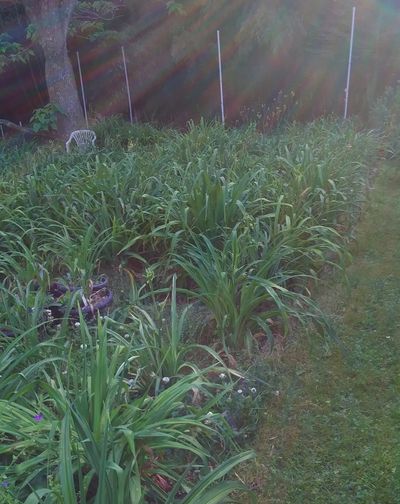Signed in as:
filler@godaddy.com
Signed in as:
filler@godaddy.com
Based upon observations in my garden and feedback from customer's gardens, where applicable.
Fully dormant and fully evergreen are the two polar extremes of the spectrum. Most daylilies fall a little bit within the area between those two poles.
Daylily foliage behavior reflects the presence of multiple minor genes in addition to two major genes for dormancy (discontinuous growth) and evergreen (continuous growth). It seems to me that heterozygotes between the two types, especially where lots of different genes that have minor effects on the major gene are segregating in the gene pool are present, can manifest a wide range of behavior that can be hard to quantify into discreet descriptions. Because of the nature of the hybridization that gave rise to our daylilies, we have a lot of signals potentially, active or carried recessively, in any given seedling or cultivar.
So the three categories of daylily foliage type - dormant, semi-evergreen and evergreen - represent the two extremes, plus the catch-all of the two extremes mixed together into a wide range of visual phenotypes. A whole host of dominant and recessive foliage type can be segregating in almost any daylily, due to their general out-breeding nature. Over time I have noticed that registered daylilies are all over the map. In my garden, someone else's dormant is very much semi-evergreen, or even evergreen. In my garden, someone's semi-evergreen may be a dormant, especially in hard winters. My experience, both in my own garden and from discussing this subject with many, many daylily growers is that foliage type can be different in different environments, except in certain rare situations when you get strong dormancy or strong evergreen growth patterns.
I register foliage type based upon what I have seen that seedling do each year throughout the years I grew it before introduction. They may vary in your garden. Many of my semi-evergreens are fully dormant in cold, northern gardens, while thriving as semi-evergreen or even evergreen plants in southern gardens, where high rust resistance can be a huge boon. Some of my dormants remain semi-evergreen or evergreen in more souther climates, and where these carry rust resistance, can also be very valuable in southern gardens. One excellent example of this is Astraea, which shows dormant foliage in my garden and in other cold-winter gardens (and is very cold hardy), but behaves as a semi-evergreen or even evergreen in some southern gardens and flourishes.
I am personally focused on dormant foliage behavior, but during my rust screening program, I needed to use evergreen and semi-evergreen cultivars to work with those resistance genes. I wanted to produce daylilies that could flourish for me, and in northern gardens in general, but also survive in more southern gardens where rust resistance could be valuable for garden use and for breeders who want to add resistance genes to their lines.
Many of my semi-evergreen introductions have been selected for their extreme hardiness in both cold and hot climates. In this way, they can be usable and survive in both more northern and more southern gardens.
What follows are the foliage types as I registered them, based upon their most frequent behavior in my garden. For more information on the hardiness and behavior of each cultivar, just click the name below to go to the full description page, or contact me about its behavior.
